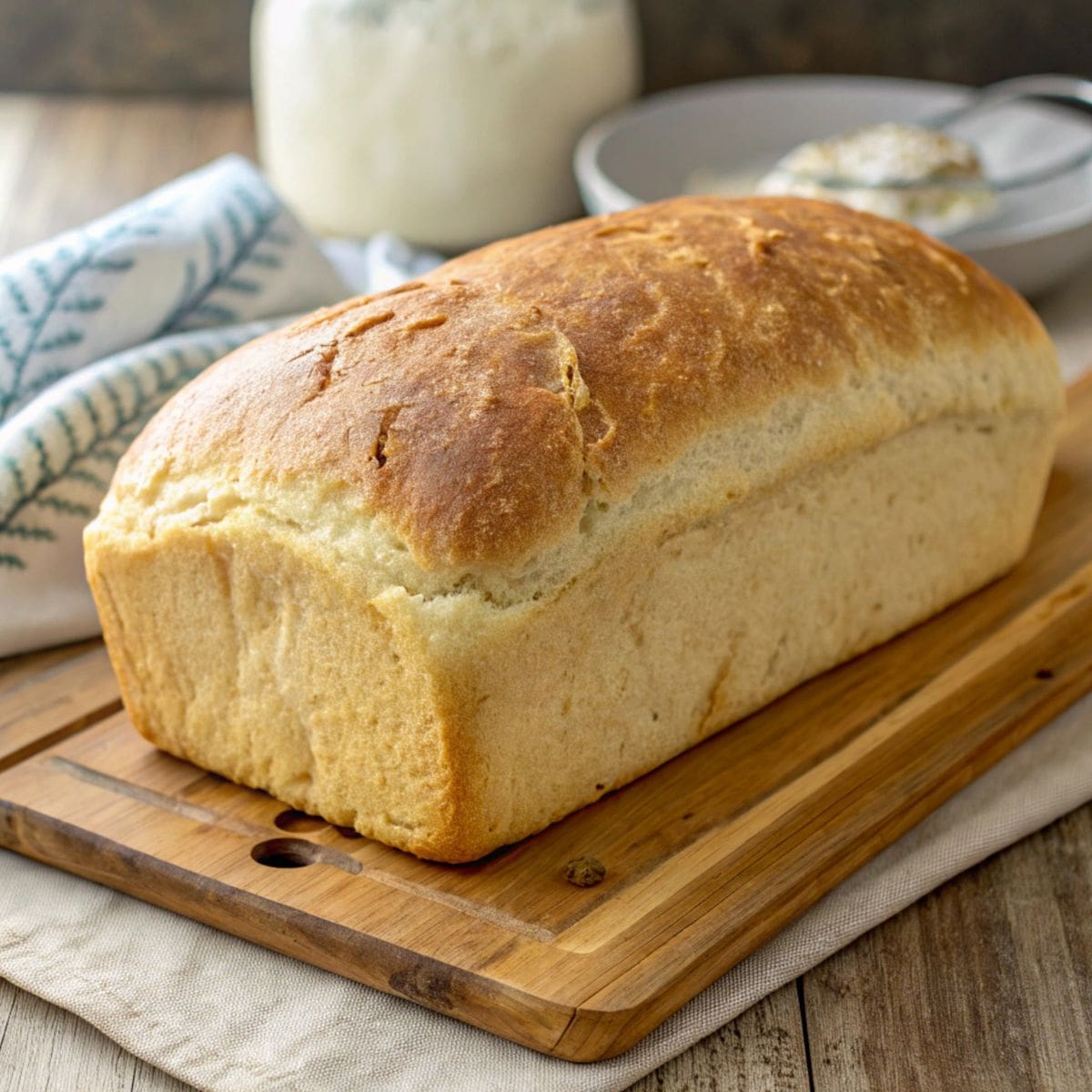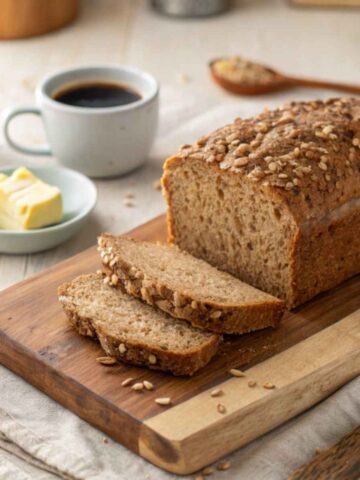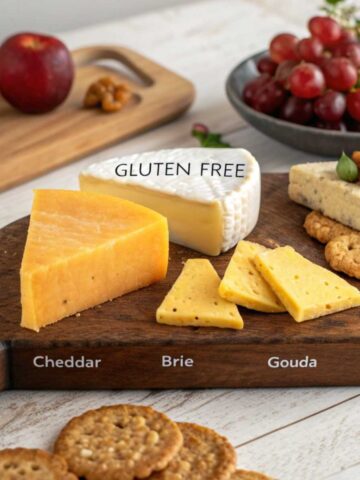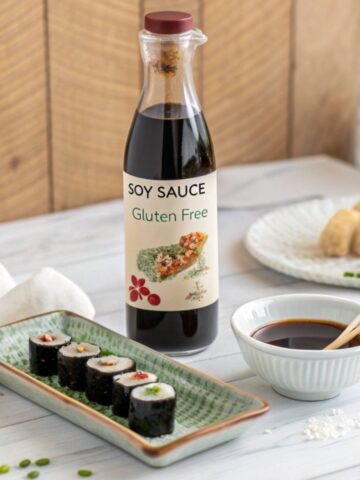Gluten-free bread has become a staple in grocery stores and cafes, proudly displayed alongside traditional loaves. But is it truly better for you? For people with gluten intolerance or celiac disease, the answer is a resounding yes—gluten-free bread is not just a choice but a necessity. However, the growing popularity of gluten-free diets has sparked curiosity among the general public, with many assuming that ditching gluten is a guaranteed path to better health.

Before you swap your whole-grain toast for a gluten-free alternative, it’s important to separate fact from fiction. Does gluten-free bread deliver the same nutritional value? Is it beneficial for everyone, or is it a solution tailored to specific needs? This article dives deep into the world of GF bread, exploring its benefits, drawbacks, and whether it’s truly a healthier option for you.
Let’s uncover the truth—slice by slice. 😊
Jump to:
- The Basics of Gluten-Free Bread
- Health Benefits of Gluten-Free Bread
- The Downsides of Gluten-Free Bread
- Comparing Gluten-Free Bread to Regular Bread
- Common Myths About Gluten-Free Bread
- Factors to Consider When Choosing Gluten-Free Bread
- Gluten-Free Bread Recipes to Try at Home
- Gluten-Free Diet Trends and Popularity
- Conclusion:
- FAQs
What is Gluten?
Gluten is a type of protein found in grains like wheat, barley, and rye. It acts as a binder, giving bread its chewy texture and elasticity. Essentially, gluten is the "glue" that helps dough rise and maintain its shape. Without it, bread would crumble easily and lack the soft, airy quality that most of us love.
But why is gluten getting so much attention lately? For some people, gluten doesn’t just contribute to the structure of their bread—it also causes health issues. This has led to an explosion of interest in gluten-free products.
Why Do Some People Avoid Gluten?
The rise of gluten-free diets stems from real medical conditions as well as lifestyle trends. For individuals with celiac disease, consuming gluten triggers an immune response that damages the small intestine. Symptoms like bloating, diarrhea, and fatigue can significantly impact their quality of life.
Even without celiac disease, some people experience non-celiac gluten sensitivity (NCGS), leading to similar discomforts without the intestinal damage. Others avoid gluten because they believe it’s healthier or helps with weight loss. But is this belief based on science or hype? Let’s dig deeper to understand how GF bread fits into the picture.
The Basics of Gluten-Free Bread
How Gluten-Free Bread is Made
Unlike traditional bread, GF bread relies on alternative ingredients to replicate the texture and structure gluten provides. Instead of wheat flour, you’ll often find rice flour, almond flour, or tapioca starch on the ingredient list. Other ingredients like xanthan gum or psyllium husk are added to mimic the elasticity of gluten.
While these substitutes work well, they don’t always match the exact taste or texture of regular bread. Many GF options tend to be denser or slightly crumbly, which can be a deal-breaker for bread lovers.
If you're curious to learn more about the various types of gluten-free bread and their unique benefits, check out this guide on Gluten-Free Bread Explained: Types, Benefits, and Baking Tips.
Nutritional Composition of Gluten-Free Bread
Here’s where things get interesting. GF bread is often lower in fiber and protein than its wheat-based counterpart. It can also be higher in calories due to added sugars or fats to improve flavor and texture. On the bright side, it’s a great option for individuals who need to avoid gluten for health reasons.
Popular Brands and Varieties
The gluten-free market has come a long way, offering a variety of choices, including sandwich bread, rolls, and even bagels. Brands like Udi’s, Schär, and Canyon Bakehouse have become household names, making gluten-free living more accessible.
Health Benefits of Gluten-Free Bread
For Those with Gluten Intolerance or Celiac Disease
For individuals with celiac disease, gluten-free bread isn’t just better—it’s essential. Consuming regular bread can cause severe inflammation and long-term damage to the digestive system. Switching to gluten-free alternatives helps avoid these issues entirely.
Benefits for Non-Celiac Gluten Sensitivity (NCGS)
If you’re one of the many people who feel bloated or sluggish after eating gluten, gluten-free bread might make a noticeable difference. While science is still uncovering the reasons behind NCGS, many individuals report improved energy levels and digestion after making the switch.
Potential Digestive Health Advantages
Even for those without gluten-related conditions, some gluten-free breads include ingredients like chia seeds or flaxseeds, which can support digestive health. These nutrient-dense additions are a win-win. However, not everything about gluten-free bread is perfect. Let’s talk about the potential drawbacks you should consider.
The Downsides of Gluten-Free Bread
Higher Calorie Content and Lower Fiber
One of the biggest drawbacks of gluten-free bread is its nutritional profile. Compared to traditional bread, it often contains more calories and less fiber. Why? To compensate for the lack of gluten, manufacturers add extra fats, sugars, or starches to improve taste and texture. Unfortunately, this can make gluten-free bread less suitable for people trying to maintain a balanced diet.
Additionally, gluten-free bread frequently lacks the whole grains found in regular bread, which are a key source of fiber. A diet low in fiber can lead to digestive issues like constipation, making it essential to supplement with other fiber-rich foods.
Cost and Accessibility
Let’s be honest: gluten-free bread is expensive. On average, it costs two to three times more than regular bread due to the specialized ingredients and production processes involved. For many families, this price difference can make going gluten-free financially challenging.
Even if you’re willing to pay the premium, finding good-quality gluten-free bread can be a hassle, especially in smaller towns or areas with fewer health food stores. Online options help, but they often come with added shipping costs.
Taste and Texture Differences
Another downside is the taste and texture. Gluten-free bread tends to be denser and lacks the soft, stretchy quality that traditional bread provides. While some brands have perfected their recipes, others still struggle to get them right, leaving consumers with products that feel crumbly or dry.
Comparing Gluten-Free Bread to Regular Bread
Nutritional Differences
When you compare the two, regular bread often has the upper hand in terms of protein and fiber. Whole-grain bread, for instance, is rich in B vitamins and essential nutrients like iron and magnesium. In contrast, gluten-free bread may lack these nutrients unless fortified.
That said, gluten-free bread eliminates a key ingredient—gluten—which can cause major health problems for some individuals. This makes it a lifesaver for those with celiac disease or gluten sensitivity.
Impact on Weight Management
There’s a common myth that gluten-free bread is inherently better for weight loss. However, this isn’t always true. Since gluten-free bread can be higher in calories and sugar, it may not align with weight-loss goals. The key lies in reading labels carefully and monitoring portion sizes.
Suitability for Different Lifestyles
Gluten-free bread is ideal for people with specific dietary needs, but it might not be necessary for everyone. For those without gluten intolerance, sticking to whole-grain bread might be a more nutritious and cost-effective choice.
Common Myths About Gluten-Free Bread
Myth 1: Gluten-Free is Always Healthier
One of the most pervasive myths is that gluten-free bread is inherently healthier than regular bread. However, this isn’t always true. While it’s essential for those with gluten-related conditions, gluten-free bread can be higher in calories, sugar, and refined starches, which may not align with a balanced diet.
In reality, health depends on the ingredients and nutritional composition. A whole-grain, fiber-rich regular bread might be a better option for people without gluten intolerance.
Myth 2: Gluten-Free Bread Helps Everyone Lose Weight
It’s easy to see why people associate gluten-free bread with weight loss—it’s often marketed as a cleaner, healthier alternative. But here’s the kicker: gluten-free doesn’t mean low-calorie. Many gluten-free breads contain added sugars and fats, which can lead to weight gain if not consumed in moderation.
For effective weight management, focus on portion control and overall dietary choices rather than relying solely on gluten-free products.
Myth 3: Gluten-Free Equals Low Carb
Another common misconception is that gluten-free bread is automatically low in carbohydrates. This couldn’t be further from the truth. Gluten-free bread often relies on starch-heavy ingredients like rice flour, tapioca starch, and potato starch, which can be just as high in carbs, if not higher, than regular bread.
If you’re looking for a low-carb alternative, options like almond flour bread or cauliflower bread might be better suited for your needs.
Factors to Consider When Choosing Gluten-Free Bread
Reading Labels and Ingredients
When shopping for gluten-free bread, don’t just grab the first loaf you see. Instead, take a moment to read the label carefully. Look for options with fewer additives and a shorter ingredient list. Bonus points if the bread is fortified with essential nutrients like iron and B vitamins.
Homemade vs. Store-Bought Options
Making GF bread at home can be a game-changer. It allows you to control the ingredients, avoid unnecessary preservatives, and experiment with flavors. However, baking gluten-free bread requires some practice and specialized ingredients like xanthan gum or psyllium husk.
If you prefer convenience, store-bought options can still be great—but choose brands with a reputation for quality and minimal processing.
Organic, Non-GMO, and Whole-Grain Options
Not all gluten-free breads are created equal. To maximize the health benefits, opt for organic or non-GMO products. Additionally, look for varieties that include whole grains like quinoa or buckwheat, which can boost the bread’s fiber and nutrient content.
Gluten-Free Bread Recipes to Try at Home
Simple Gluten-Free Sandwich Bread

This basic recipe is perfect for everyday use, whether you’re making sandwiches or toast.
Ingredients:
- 2 cups gluten-free all-purpose flour
- 1 teaspoon xanthan gum (if not included in your flour mix)
- 1 teaspoon salt
- 1 tablespoon sugar
- 1 packet (2 ¼ teaspoons) active dry yeast
- 1 cup warm water
- 2 tablespoons olive oil
- 2 large eggs
Instructions:
- Mix the warm water, sugar, and yeast in a bowl. Let it sit for 5-10 minutes until it becomes frothy.
- In a separate bowl, combine the flour, xanthan gum, and salt.
- Add the yeast mixture, olive oil, and eggs to the dry ingredients. Mix thoroughly until you have a smooth batter (it will be more like cake batter than traditional dough).
- Pour the batter into a greased loaf pan and cover with a clean towel. Let it rise in a warm spot for about 30-40 minutes.
- Preheat the oven to 375°F (190°C). Bake the bread for 30-35 minutes or until golden brown.
- Let it cool before slicing.
Looking for more inspiration? Here’s a detailed guide to creating a Soft, Delicious, and Easy Gluten-Free Bread you can bake at home.
Gluten-Free Banana Bread

A deliciously sweet and moist bread for breakfast or dessert.
Ingredients:
- 3 ripe bananas, mashed
- 2 cups gluten-free flour
- 1 teaspoon baking soda
- ½ teaspoon salt
- ½ cup sugar or honey
- ⅓ cup melted coconut oil or butter
- 2 large eggs
- 1 teaspoon vanilla extract
Instructions:
- Preheat your oven to 350°F (175°C). Grease a loaf pan.
- In a bowl, whisk together the mashed bananas, sugar, coconut oil, eggs, and vanilla.
- In another bowl, mix the gluten-free flour, baking soda, and salt. Gradually fold the dry ingredients into the wet mixture until combined.
- Pour the batter into the loaf pan and smooth the top.
- Bake for 50-60 minutes or until a toothpick inserted into the center comes out clean.
- Allow the bread to cool before slicing and serving.
Tips for Perfect Gluten-Free Baking
- Measure Accurately: Use a kitchen scale for precise measurements, as gluten-free baking is less forgiving than traditional baking.
- Use Binders: Ingredients like xanthan gum or psyllium husk help mimic the elasticity of gluten.
- Don’t Overmix: Overmixing can lead to a dense, gummy texture. Combine ingredients just until incorporated.
- Let It Rest: Allowing the dough or batter to rest before baking can improve texture and flavor.
Interested in making gluten-free sourdough from scratch? Start with this helpful guide to creating a Gluten-Free Sourdough Starter.
Gluten-Free Diet Trends and Popularity
Why Gluten-Free Became a Buzzword
The gluten-free diet started gaining traction as a necessity for individuals with celiac disease, but over time, it transformed into a mainstream health trend. Why? Part of the credit goes to celebrities and wellness influencers who championed gluten-free living as a way to improve energy levels, promote weight loss, and enhance overall health.
Moreover, the availability of gluten-free products skyrocketed, making it easier for people to adopt this lifestyle. From bread to pasta and even desserts, almost every food category now has gluten-free alternatives.
The Science Behind Gluten-Free Diets
So, is there scientific backing for gluten-free diets? For individuals with celiac disease or gluten sensitivity, the benefits are undeniable. Eliminating gluten helps prevent symptoms like bloating, diarrhea, fatigue, and long-term intestinal damage.
However, for the general population, there’s limited evidence that going gluten-free offers significant health benefits. Some studies suggest that avoiding gluten unnecessarily could lead to deficiencies in nutrients like fiber, B vitamins, and iron, which are abundant in wheat-based products.
Sourdough fans may wonder if they can enjoy their favorite bread while staying GF. Read more in this detailed guide on Is Sourdough Bread Gluten-Free? A Comprehensive Guide to Understanding and Enjoying Sourdough.
Is Gluten-Free Just a Fad?
While it’s true that the gluten-free craze has elements of a fad, it’s not entirely baseless. For those with gluten-related conditions, this diet is a medical necessity. For others, it can be a conscious choice tied to personal health goals or preferences.
That said, the gluten-free trend may have staying power because it aligns with the broader movement toward mindful eating and specialized diets. Whether it’s keto, paleo, or gluten-free, people are increasingly tailoring their diets to meet individual needs.
Conclusion:
The answer to whether gluten-free bread is better for you depends on your specific health needs. For those with celiac disease or gluten sensitivity, gluten-free bread is a must-have that prevents discomfort and serious health complications. However, if you don’t have issues with gluten, there’s no clear evidence that gluten-free bread is a healthier choice. Regular whole-grain bread may offer better nutritional value at a lower cost.
Ultimately, the decision comes down to what works best for your body and lifestyle. If you enjoy the benefits of GF bread or feel better without gluten in your diet, go for it! Just remember to read labels, compare nutritional content, and choose options that align with your health goals.
FAQs
Not necessarily. While it’s essential for people with gluten intolerance or celiac disease, gluten-free bread can be higher in calories and lower in fiber compared to regular whole-grain bread. Always check the nutritional label.
No, not directly. Gluten-free bread often contains more calories and sugar than traditional bread. Weight loss depends on your overall diet and portion control.
Great alternatives include almond flour bread, coconut flour bread, and cauliflower-based bread. These options are often lower in carbs and higher in nutrients.
Gluten-free bread can sometimes lack essential nutrients like fiber and B vitamins. To avoid deficiencies, pair it with a balanced diet rich in whole foods.
If you experience symptoms like bloating, diarrhea, or fatigue after eating gluten, consult a healthcare professional for testing. They can determine if you have celiac disease or gluten sensitivity.





Leave a Reply